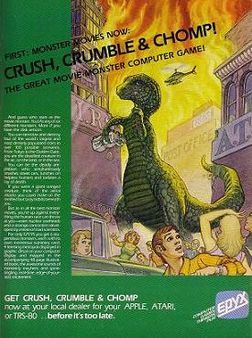- Crush, Crumble and Chomp!
-
Crush, Crumble and Chomp! 
Cover artDeveloper(s) Epyx Publisher(s) Epyx Designer(s) Jon Freeman & Jim Connelley Platform(s) Apple II, Atari 400/800/XL/XE, Commodore 64, Commodore VIC-20, DOS, TRS-80 Release date(s) Genre(s) Strategy Mode(s) Single-player Rating(s) N/A Media/distribution Compact Cassette or one 5¼" disk Crush, Crumble and Chomp! is a 1981 computer game from Epyx.[1] In this game, the player takes control of a movie monster and attacks a famous city, such as New York or San Francisco. It resembles SPI's 1979 boardgame, The Creature That Ate Sheboygan.
Contents
Description
Crush, Crumble and Chomp! was a turn-based action game played on a scrolling 2D grid-based map. The game engine was written in BASIC and used character graphics for the map and player, using basic graphics on platforms that supported it. On the Atari 8-bit family, for instance, the map was created out of a custom character set and presented in a low-resolution mode that allowed up to four colors. The same engine was used in most of Epyx's games from the early 1980s, which allowed them to be ported to a variety of home computer platforms with ease.
The game allows the player to recreate a movie monster and attack a city, much in the manner of the classic horror movies of the 1950s. Specifically, the player can create:
- Goshilla, a giant amphibian like Godzilla, with a breath and leaving a corrosive trail of radioactive waste.
- The Kraken, a giant octopus or squid-like monster, that can attack bridges and seaside ports and then slip into the water to hide from attack. However, the Kraken could not go on land.
- Arachnis, a giant spider, can clog roads with its web and can escape underground via its network of secret tunnels. Arachnis could tunnel underwater, but if emerging in water it was trapped, and could not move, and needed to tunnel back to dry land.
- The Glob, akin to the monster in The Blob, can travel underground in the city's sewer and absorb obstacles in its path, including skyscrapers. It also leaves a flammable trail of slime in its wake. The Glob shared Arachnis' tunneling ability, but also its limitation.
- Mechismo, a towering robotic menace, sports an exotic array of alien weaponry, such as ray guns. It had the advantage over the other monsters in that it did not need to capture and eat people to survive. This was countered by the fact that, as a non-lifeform, it could not heal; the game's customization could allow the player to build a self-repairing robot, but this required a prohibitive amount of "crunch credits."
- Mantra, a giant flying monster, like the infamous Mothra. Mantra could fly over water, but, if landing in it, was stuck as if Arachnis or The Globe emerging from its tunneling.
The game also allows the player to "grow" their own monster, with several basic shapes to choose from and a number of "crunch credits" to spend on custom abilities. The number of credits available, and the cost of some abilities, depends on the shape chosen. The player can add a number of abilities until their credits are exhausted.
Crush, Crumble and Chomp! features four cities to attack: San Francisco, New York, Washington DC and Tokyo. Combined with five possible objectives and the six (or numerous ones, counting the custom) monsters, this game has robust replayability. After attacking a city—the main activity of the game—players are rated on how well they did. Players are rated even if their monsters die in the attack and can achieve a high score for what they accomplished before expiring.
Ports
Like many of Epyx's games of this period, it was released for several of the popular home computers of the era. It was originally released for the TRS-80, Apple II and Atari 8-bit series, but was soon ported to the VIC-20, Commodore 64 and DOS. The first two versions were marketed under the name "Automated Simulations", the name of the company that would eventually become Epyx. The two later versions, released in 1983, were released under the Epyx name.
Reception
The game was reviewed in 1982 in The Dragon #65 by Bruce Humphrey. Humphrey concluded that "The game system isn’t perfect, from the player/monster point of view," but "The game is satisfying, however, from a fun-to-play standpoint, and that counts more."[2]
Legacy
This is one of the few games of the home computer era that allowed the player to control a classic movie monster. The only other notable home computer game of the era that featured player-controlled monsters was Electronic Arts' Mail Order Monsters. However the game featured a different premise—monsters battling one another—instead of monsters attacking an unsuspecting metropolis like the classic monster movies of the '50s.
Besides being the single game that allowed the player to take control of a classic movie monster, this game may have served as inspiration for the arcade game Rampage. Bally Midway's Rampage lets the player take on the role of one of three classic movie monsters, a giant Godzilla-like lizard, a giant werewolf or a King Kong-like ape. In Rampage, the player(s) also attack unsuspecting cities. Like Crush, Crumble and Chomp!, Rampage also uses real cities as its settings.
Other games which have used the same concept were King of the Monsters which was released in 1991 for the Neo-Geo, and War of the Monsters for the PlayStation 2, released in 2003. However, in these games a monster would battle other monsters in cities. It combined several elements of the classic horror movies in one big fight.
See also
References
- ^ Crush, Crumble and Chomp! at MobyGames
- ^ Humphrey, Bruce (September 1982). "Campaigns for the Keyboard". The Dragon (65): 73–74.
External links
Categories:- 1981 video games
- Epyx games
- Apple II games
- Atari 8-bit family games
- Commodore 64 games
- DOS games
- Kaiju video games
Wikimedia Foundation. 2010.
